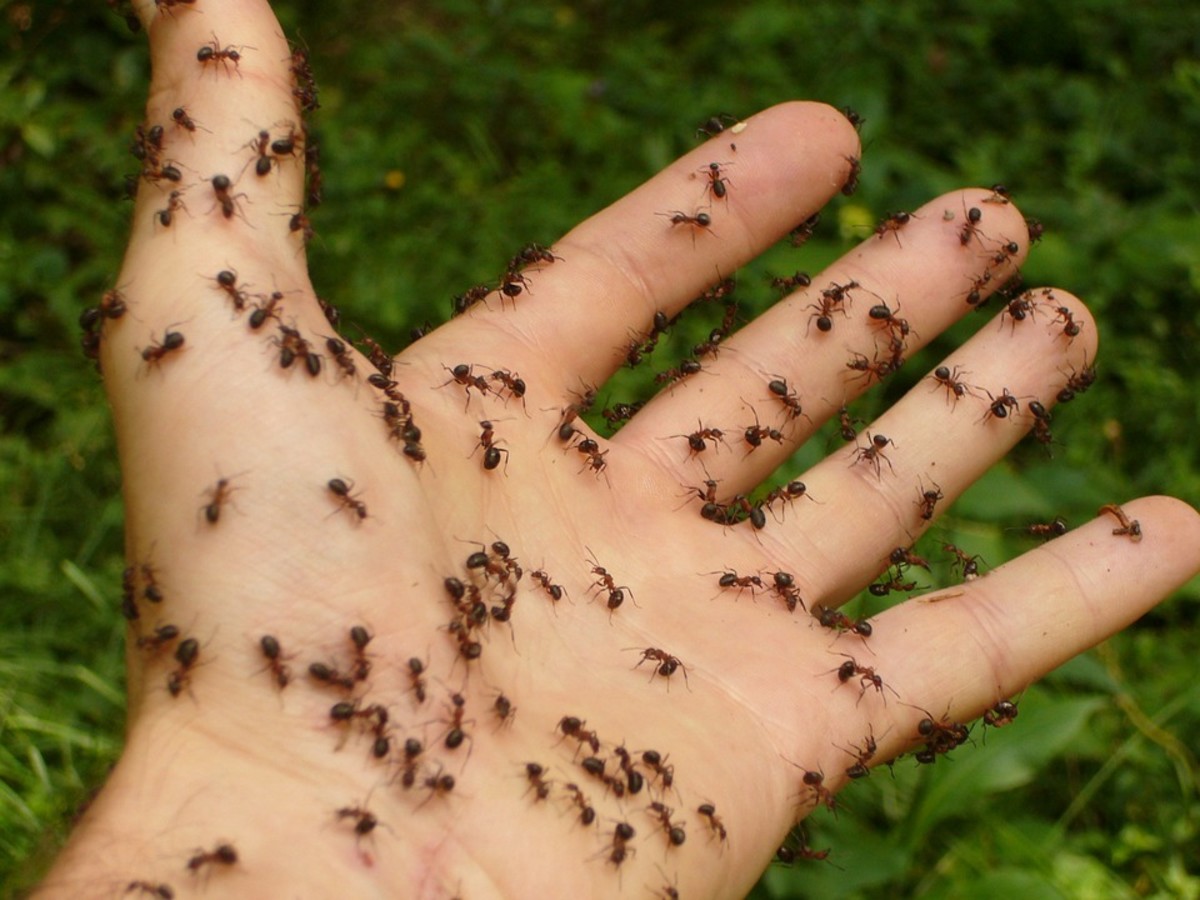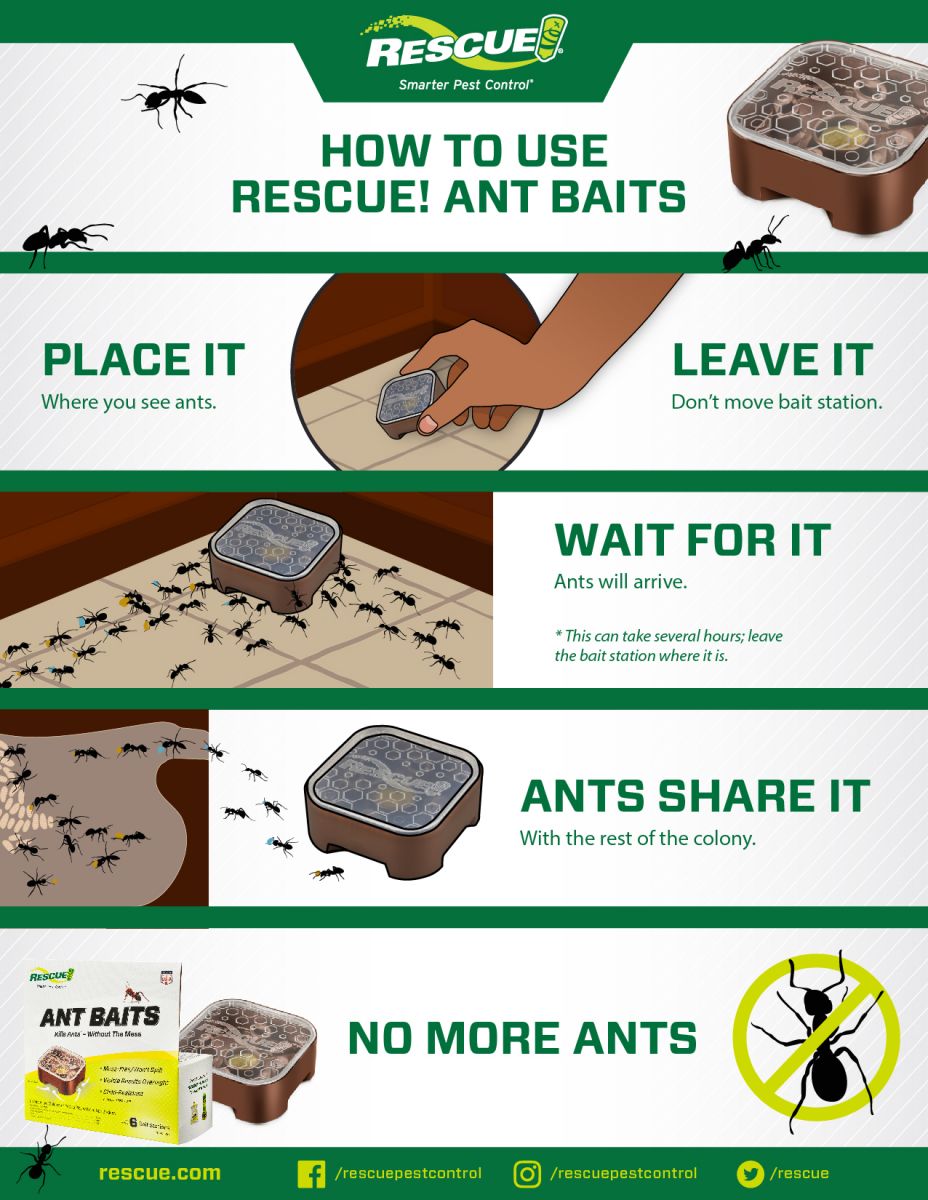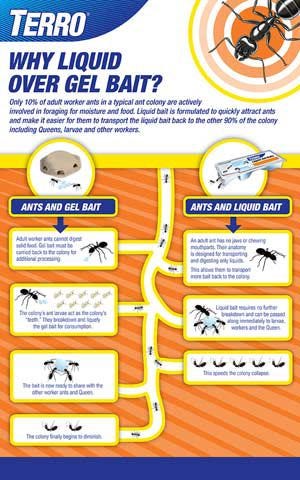Ant traps typically work within 24 to 48 hours. Effective results depend on the type of trap and the bait used.
Dealing with an ant infestation can be a significant nuisance, but ant traps offer a practical solution to help eradicate these persistent pests from your environment. Available in various forms, such as baits, gels, and stations, ant traps are designed to attract ants with enticing scents and flavors.
Once foragers bring the poisonous bait back to their colony, it can exterminate the entire nest over time. Determining the most suitable type of trap is crucial, as it should target the specific ant species invading your space. An ant trap’s success hinges on strategic placement in areas where ant activity is frequent, thus ensuring the pests are drawn to the trap and distribute the lethal bait throughout their colony.

Credit: dengarden.com
Ant Infestation In Homes
Discovering a line of ants marching through your home can be frustrating. Ants intrude in search of food, water, and shelter. Effective ant control starts with knowing your enemy and understanding the infestation.
Common Types Of Household Ants
Several ant species invade homes. Recognizing each type is crucial for successful elimination.
- Carpenter ants – damage wood structures.
- Sugar ants – attracted to sweets.
- Fire ants – sting and may cause allergies.
- Odorous house ants – emit a rotten smell when crushed.
Identifying Signs Of An Ant Problem
Timely detection of ant activity is critical. Look for trails of ants, especially towards food sources.
| Sign | Description |
|---|---|
| Live ants | A large number means a nearby nest. |
| Ant paths | Invisible pheromone trails lead them to food. |
| Nest sites | Soil mounds or wood holes indicate nests. |
Address these signs swiftly with targeted ant traps.
The Basics Of Ant Traps
Understanding the fundamentals of ant traps is crucial for effective ant control. These traps are quite straightforward, but their efficiency hinges on several factors. A firm grasp on how these devices work can lead to a bug-free home.
How Ant Traps Function
Ant traps are not your ordinary catch-and-kill solutions. They are cleverly designed baits that offer a double-edged sword. First, ants are lured in by the bait. The bait, usually a sugary substance laced with poison, is then carried back to the colony. This is where the second phase kicks in.
- Workers gather the bait, thinking it’s food.
- A slow-acting poison ensures ants don’t die immediately.
- The toxic substance is shared throughout the colony.
- Eventually, the queen is affected, halting reproduction.
- The entire colony collapses due to the domino effect.
Different Varieties Of Ant Traps
Ant traps come in different shapes and sizes, each serving a unique purpose. The selection available ensures homeowners find the perfect fit for their situation. Below is an overview:
| Type | Active Ingredient | Best For |
|---|---|---|
| Gel Bait | Fipronil or Borax | Cracks and crevices |
| Station Bait | Indoxacarb or Hydramethylnon | Indoor and Outdoor use |
| Granule Bait | Boric Acid or Pyrethroids | Yards or larger areas |
| Liquid Bait | Borax or Thiamethoxam | Immediate ant activity |
Using the right trap can make all the difference in ant control. Know the targeted species and the area needing treatment. Then select the trap that best aligns with these needs.
Optimal Conditions For Trap Effectiveness
Optimal Conditions for Trap Effectiveness play a crucial role in the battle against ants invading your space. Understanding when and how to set up ant traps can make all the difference. Let’s explore the elements that can turn the tide in favor of an ant-free home.
Best Locations For Placing Ant Traps
To maximize the effectiveness of ant traps, placing them correctly is key. Ants follow pheromone trails to food sources. So, traps should be near these paths. Key spots include:
- Kitchen counters – where crumbs and spills are common.
- Cabinets and pantries – especially if sweets or starches are stored.
- Near appliances – since warmth and moisture attract ants.
- Windowsills and doorsteps – entry points that ants often use.
- Bathroom corners – where dripping water provides a water source.
Ensure traps remain undisturbed and check them regularly to see if they need replacing.
Environmental Factors Affecting Trap Success
The environment around ant traps greatly influences their success. Key factors include:
| Environmental Factor | Explanation | Optimal Condition |
|---|---|---|
| Moisture | Ants seek water, so damp areas can draw them in. | Use moderate moisture to attract, without warping the trap. |
| Temperature | Ants are less active in extreme temperatures. | Room temperature is ideal for traps to work effectively. |
| Food availability | Excess food competes with trap baits. | Keep surrounding areas clean to funnel ants into traps. |
| Light | Some ant species prefer dark areas. | Place traps in shaded areas or along walls where ants travel. |
Create the best possible scenario for your ant traps by controlling these environmental factors. Success follows when ants find the traps hard to resist.
The Role Of Bait In Ant Traps
Battling an ant invasion requires more than just setting up traps; it’s about the bait. Think of it as a siren song for ants, luring them in. The effectiveness of traps largely hinges on the bait used. Let’s explore how the right bait can lead to a pest-free home.
Selecting The Right Bait
Choosing bait that appeals to the ants in your home is crucial. Different species prefer different food sources. Protein-loving ants might turn up their antennae at sugary baits, and vice versa.
A bait’s success also depends on the ant colony’s cycle. Breeding periods require protein-rich bait, while carbohydrates may be more enticing during other times.
Why Bait Attractiveness Matters
Bait attractiveness is pivotal for luring ants into traps. A bait that’s irresistible ensures ants will not only take it but also share it within their colony.
- Attractive bait means more ants targeted.
- Ensures transfer of poison back to the nest.
- Effective for long-term control of the infestation.
Persistent ant issues demand smart bait strategy. Today, you are well-equipped to pick the right bait, seduce those pesky intruders, and reign victorious in the battle against ants.
Timing Is Key
War with ants demands strategy, particularly clockwork precision. Knowing when to deploy weaponry – in this case, ant traps – can mean the difference between victory and ongoing skirmish. Catch these tiny invaders on time, and your battle will be swift.
Understanding Ant Colony Cycles
Ants operate on a cycle that’s tuned to the seasons. In spring, they emerge, hungry and ready to build their empire. During summer, their quest for food peaks, often leading them indoors. Come fall, activity slows as they prepare for winter. Targeting the right cycle stage is crucial for effective control.
- Spring: Colonies expand, scouts search for food.
- Summer: Feeding frenzy, heightened indoor invasions.
- Fall: Pre-winter preparations, reduced activity.
- Winter: Dormant phase, hidden from sight.
When To Set Up Ant Traps
Installing ant traps aligns with these cycles for ultimate effectiveness. Spring scouts can lead an entire colony to doom. By summer, a well-placed trap could intercept those foraging worker ants. The rule of thumb: place traps when you first notice ants, or ideally, just before the season they emerge.
| Season | Timing for Trap Setup |
|---|---|
| Spring | Early, as ants begin to appear |
| Summer | At first sign of indoor activity |
| Fall | Less effective, but can prepare for next cycle |
| Winter | Generally not needed |
Remember, consistency is key. Regular replacement of traps ensures ongoing protection. Pair traps with clean, crumb-free surfaces, and the ant parade will turn tide.

Credit: www.terminix.com
Assessing Ant Trap Performance
Discovering whether your ant trap is a mighty insect eliminator or just another piece of decor starts with performance assessment. Effective ant control requires not only setting up the traps but also understanding how to gauge their success. Let’s learn how to monitor this process and steer clear of common mistakes.
Monitoring Trap Success
Ant trap efficiency shines when you know where to look. Keep an eye on the following:
- Ant traffic: Observe changes in the number of ants marching toward the traps.
- Bait consumption: Is the bait disappearing? A good sign that ants are taking the poison back to the colony.
- Decreased sightings: Fewer ants around your space generally means success.
Document these observations regularly over weeks for the best insight into your trap’s performance.
Common Pitfalls To Avoid
Falling into ant trap pitfalls can undermine your pest control efforts. Watch out for these common errors:
- Wrong placement: Place traps near ant paths, not just randomly around the house.
- Not replacing traps: Over time, baits lose their potency; refresh them periodically.
- Ignoring cleanliness: Keep areas clean to prevent ants from bypassing your traps.
Correct these mistakes to maximize your chances of reclaiming your ant-free space.
Maintenance And Replacement
Effective maintenance and timely replacement are crucial for ant traps to work. Let’s discuss the best practices for keeping ant traps at peak efficiency.
How Often To Change Ant Traps
Ant traps don’t last forever. Regular changes are essential. The frequency can vary based on the product, ant activity, and the environment.
- Every 3 months is a standard recommendation.
- High-traffic areas may require more frequent changes.
- For best results, check manufacturer’s instructions.
Signs That It’s Time For A New Trap
Knowing when to replace an ant trap is key to preventing infestations.
| Sign | Action Needed |
|---|---|
| Trap is full of ants | Replace immediately |
| No ant activity | Replace to ensure freshness |
| Damaged trap | Replace to maintain effectiveness |
| After 3 months | Refresh with a new trap |

Credit: www.rescue.com
Complementary Ant Control Strategies
Effective ant control often requires more than setting traps. Combine different strategies to keep these tiny invaders at bay. Implementing an integrated approach ensures better results and a cleaner home.
Integrating Traps With Other Methods
For maximum efficiency, ant traps should work hand-in-hand with additional control techniques. Here’s how to bolster your ant-fighting arsenal:
- Use baits: Position ant baits near trails and colonies. Baits combined with traps form a powerful duo.
- Apply insecticide: A non-repellent insecticide targets ants you don’t see. It complements ant traps effectively.
- Seal entry points: Fill cracks and crevices to prevent new ants from entering. This step enhances trap effectiveness by reducing incoming traffic.
- Maintain cleanliness: A tidy space leaves ants with fewer resources. Ensure to clean counters, floors, and dispose of garbage regularly.
Preventive Measures To Keep Ants Away
Prevention is crucial in ant control. Follow these simple yet effective steps:
| Preventive Step | Benefit |
|---|---|
| Store food properly | Keeps ant attractants out of reach. |
| Avoid standing water | Eliminates moisture that ants seek. |
| Regularly empty trash bins | Removes potential ant food sources. |
| Trim vegetation away from home | Reduces ant access points. |
Constant vigilance and routine maintenance play critical roles in keeping ants at a distance. Embark on a plan that involves both, and watch the ant populations dwindle.
Professional Pest Control
Professional Pest Control offers a robust solution against ant invasions. While DIY ant traps might offer temporary relief, sometimes the problem runs deeper. Recognizing when to call in pest control experts often saves time, money, and frustration. Experts bring specialized knowledge and tools to handle infestations thoroughly.
When To Call The Experts
- Recurring ant issues despite using various DIY methods
- Noticing large ant colonies or nests around your property
- Presence of sawdust trails signaling wood-destroying species
- Health concerns caused by ant bites or allergic reactions
What To Expect From Professional Services
Opting for professional services translates into a comprehensive ant control strategy. Let’s look at what professionals can offer.
Detailed Inspection
Experts start with an in-depth analysis of your home to pinpoint the source and extent of the infestation.
Custom Treatment Plans
Professionals create treatment strategies tailored to your particular ant problem and environment.
Advanced Methods and Tools
Beyond traps, professionals use powerful insecticides and growth regulators that are not available over the counter.
Follow-up and Prevention Advice
Post-treatment, expect tips for preventing future infestations and proposals for ongoing maintenance visits.
Guaranteed Results
Most services come with a guarantee, ensuring that the problem gets fixed or they’ll return to provide additional treatments.
| Service Feature | Benefit |
|---|---|
| Expertise & Experience | Better understanding of ant behavior and effective treatment methods |
| Customized Solutions | Address the specific needs of your home and the ant species present |
| Advanced Treatments | Access to professional-grade chemicals and tools for longer-lasting results |
| Preventative Strategies | Guidance on how to avoid future infestations |
Safety Considerations And Precautions
Ensuring safety is vital when dealing with ant traps. Homeowners should consider potential risks to family members, especially children and pets. This section delves into important safety measures to practice while using ant traps to keep your home free from these pesky invaders, yet safe for all.
Child And Pet Safety With Traps
Ant traps often contain poisons that are harmful if ingested. Keep these products out of reach to ensure the well-being of your children and furry friends. Follow these tips to maintain a safe environment:
- Place traps in hidden areas where only ants can access them.
- Opt for child-resistant and pet-safe ant traps. These are designed to prevent easy access.
- Monitor children and pets regularly to ensure they do not tamper with the traps.
- In case of accidental ingestion, seek medical help immediately.
Proper Disposal Of Ant Traps
Discarding used ant traps requires attention to detail. Follow these steps for proper disposal:
- Always wear gloves to protect your hands from any residual chemicals.
- Wrap the ant trap in paper before placing it into a sealed bag.
- Check your local regulations for disposing of household chemicals.
- Ensure the sealed bag is thrown in an outside trash bin.
- Wash your hands thoroughly after handling and discarding the traps.
Never reuse ant traps. Even if they appear unused, chemicals deplete over time and become ineffective.
Frequently Asked Questions For When Do Ant Traps Work
When Should You Set Ant Traps?
To achieve the best results, set ant traps as soon as you notice an ant infestation. Ant activity typically increases in the spring and summer, so these seasons are crucial for placement. Early intervention prevents larger colonies from establishing.
Do Ant Traps Attract More Ants Initially?
Yes, ant traps may attract more ants initially. This is because the bait inside the trap is designed to lure ants. Over time, the bait’s poison is carried back to the nest by worker ants, reducing the overall population.
Can Ant Traps Be Used Indoors And Outdoors?
Certain ant traps are suitable for both indoor and outdoor use. Always check the product label for specific usage instructions. Outdoor traps are generally more weather-resistant, while indoor traps may be designed to be discreet and safe around pets and children.
How Long Do Ant Traps Take To Work?
Ant traps typically begin working within 24 to 48 hours. However, it may take up to several weeks to notice a significant decrease in ant activity. The time frame depends on the size of the infestation and the species of ants.
Conclusion
Understanding the right time to set ant traps is key to effective pest control. Ensure you identify the ant species and their patterns before placement. Seasonal changes often dictate the best timing for success. By following these steps, your ant problem can become a thing of the past, ensuring a pest-free home all year round.

I’m MD Tanvir, and I bring years of expertise gained from working closely with pest control companies to the forefront. My journey in the industry has inspired me to launch Bug Battler, a platform aimed at equipping people with the know-how to combat pests autonomously. Through Bug Battler, I aim to empower individuals with practical insights to tackle pest infestations effectively.

